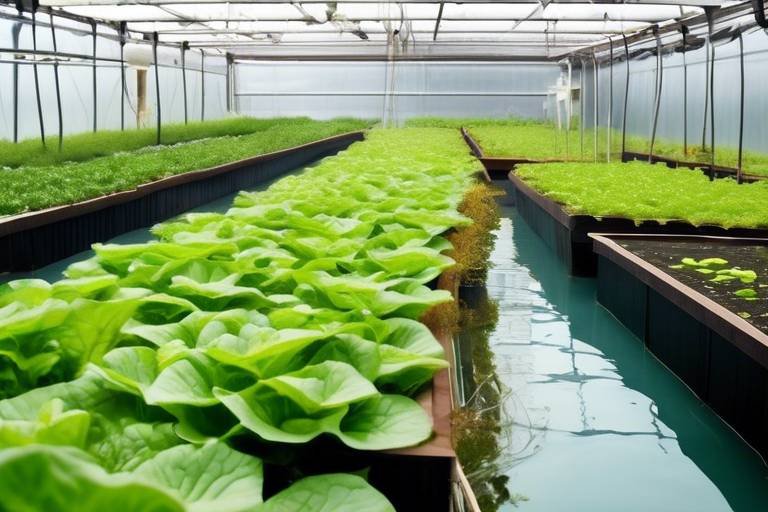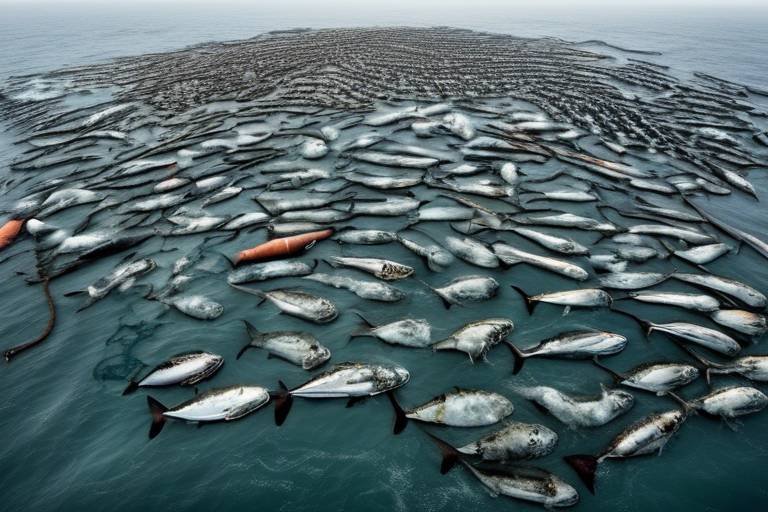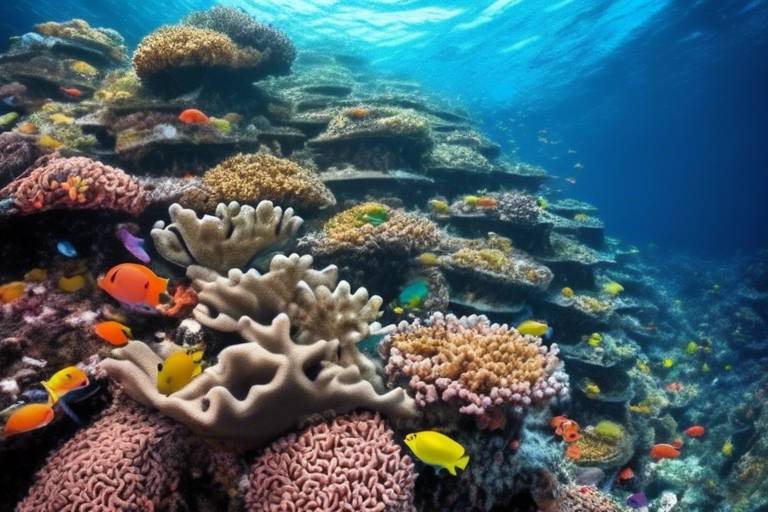What Role does Aquaponics Play in Sustainable Agriculture?
Aquaponics is emerging as a revolutionary force in the realm of sustainable agriculture, and its role cannot be overstated. Imagine a farming system where fish and plants thrive together in a symbiotic environment—this is the essence of aquaponics. By merging aquaculture (raising fish) with hydroponics (growing plants in water), aquaponics presents a unique solution to some of the pressing challenges faced by traditional agricultural practices. It not only provides a sustainable method of food production but also addresses critical issues such as water scarcity, soil degradation, and the need for chemical fertilizers.
In a world where the population is skyrocketing and arable land is shrinking, aquaponics offers a glimmer of hope. It utilizes a closed-loop system that recycles water and nutrients, making it incredibly efficient. For instance, while conventional farming can require up to 1,800 gallons of water to produce a single pound of beef, aquaponics can yield a similar amount of produce with a fraction of that water. This efficiency is crucial as we strive to meet the food demands of an ever-increasing population while minimizing our environmental footprint.
Moreover, aquaponics promotes biodiversity—a key factor in resilient ecosystems. By cultivating a variety of fish species alongside a diverse array of plants, aquaponics systems contribute to a balanced ecosystem that can withstand pests and diseases more effectively than monoculture farming. This biodiversity not only enhances the health of the farming system but also supports the surrounding environment, making aquaponics a win-win for both producers and nature.
As we delve deeper into the environmental benefits, economic viability, and innovative practices that aquaponics brings to sustainable agriculture, it becomes clear that this method is not just a trend; it is a transformative approach that can redefine how we think about food production. The integration of technology and community engagement further amplifies its potential, making aquaponics an exciting frontier for both farmers and consumers alike. So, how can we harness the power of aquaponics to create a more sustainable future? Let's explore this fascinating topic further.
- What is aquaponics? - Aquaponics is a sustainable farming method that combines aquaculture and hydroponics, allowing fish and plants to grow together in a symbiotic environment.
- How does aquaponics save water? - Aquaponics uses a closed-loop system that recycles water, leading to significantly lower water usage compared to traditional farming methods.
- What are the economic benefits of aquaponics? - Aquaponics can reduce operational costs, increase yields, and provide unique market opportunities as consumer demand for sustainable food grows.
- Can aquaponics support biodiversity? - Yes! Aquaponics systems can support a diverse range of plants and fish species, promoting ecological balance and resilience.

Understanding Aquaponics
Aquaponics is an innovative and sustainable farming method that combines two distinct yet complementary systems: aquaculture, which is the cultivation of aquatic animals like fish, and hydroponics, the growing of plants in a water-based nutrient solution. Imagine a harmonious ecosystem where fish and plants thrive together, each benefiting from the other's presence. In this system, fish waste provides an organic nutrient source for the plants, while the plants help filter and purify the water for the fish. This symbiotic relationship not only maximizes resource efficiency but also minimizes waste, making aquaponics a truly sustainable solution for modern agriculture.
The basic principles of aquaponics are rooted in the natural cycles found in ecosystems. When fish are raised in tanks, they produce waste, which contains ammonia. This ammonia is converted into nitrites and then nitrates by beneficial bacteria in the system. The plants absorb these nitrates as nutrients, effectively cleaning the water that is then recirculated back to the fish tanks. This closed-loop system significantly reduces the need for chemical fertilizers and promotes a healthier environment for both aquatic life and crops.
Aquaponics systems can vary widely in scale and complexity, from small backyard setups to large commercial operations. Some common components of an aquaponics system include:
- Fish Tanks: Where the aquatic animals are raised.
- Grow Beds: Containers filled with a growing medium where plants are cultivated.
- Pumps and Plumbing: To circulate water between the fish tanks and grow beds.
- Bacterial Colonies: Essential for converting fish waste into nutrients.
One of the most attractive aspects of aquaponics is its potential for high efficiency and productivity. For instance, aquaponic systems can produce up to 10 times more food per square foot than traditional farming methods, all while using significantly less water. This efficiency is particularly crucial in areas facing water scarcity or poor soil conditions. Additionally, aquaponics can operate in urban environments, bringing food production closer to consumers and reducing transportation costs and carbon footprints.
In summary, aquaponics represents a forward-thinking approach to agriculture that aligns perfectly with the principles of sustainability. By harnessing the natural relationships between fish and plants, aquaponics not only provides a reliable source of fresh produce and protein but also contributes to environmental conservation. It's a win-win situation that encourages innovation and sustainability in food production.

Environmental Benefits
Aquaponics offers a plethora of environmental advantages that make it a standout method in the realm of sustainable agriculture. By integrating fish farming with plant cultivation, aquaponics creates a closed-loop system that minimizes waste and maximizes resource efficiency. This innovative approach not only conserves water but also reduces the need for chemical fertilizers, promoting a healthier ecosystem. Imagine a world where farming doesn't deplete our precious water resources or pollute our land and waterways—this is the promise of aquaponics.
One of the most remarkable features of aquaponics is its ability to conserve water. Traditional farming methods can consume vast amounts of water, often leading to depletion of local water sources. In contrast, aquaponic systems use about 90% less water than conventional farming. This is achieved through a process of recycling water, where the water from fish tanks is filtered and then used to nourish plants. Once the plants absorb the nutrients, the water is returned to the fish tanks, creating a sustainable cycle. This efficient use of water not only saves resources but also helps mitigate the impact of droughts and water shortages in agricultural regions.
In terms of water pollution, aquaponics shines brightly. By utilizing fish waste as a natural fertilizer, aquaponics eliminates the need for synthetic fertilizers that can leach into waterways and cause significant environmental damage. This natural nutrient cycle contributes to cleaner water systems and healthier ecosystems. The waste produced by fish is rich in nitrogen, which is essential for plant growth. As the plants take up these nutrients, they help to filter and purify the water, creating a symbiotic relationship that benefits both aquatic and terrestrial life.
Moreover, aquaponics also has a profound impact on soil health. Since aquaponic systems operate without soil, they help preserve soil integrity and prevent erosion. Traditional farming practices often lead to soil degradation due to over-farming, chemical runoff, and erosion. By eliminating the reliance on soil, aquaponics not only conserves land but also encourages the preservation of existing natural habitats. This is crucial for maintaining biodiversity and ecological balance, as healthy ecosystems are vital for the survival of countless species.
When it comes to biodiversity, aquaponics systems can support a diverse range of plants and fish species. This diversity is essential for creating a balanced ecosystem that can withstand pests and diseases. In aquaponics, the variety of plants grown can range from leafy greens to herbs and even fruit-bearing plants, while the fish species can vary from tilapia to catfish. The ability to cultivate multiple species in a single system not only enhances biodiversity but also contributes to a more resilient agricultural practice.
Overall, the environmental benefits of aquaponics are extensive and far-reaching. It conserves water, reduces pollution, preserves soil health, and enhances biodiversity—all critical components of sustainable agriculture. As we face the challenges of climate change and resource depletion, aquaponics stands out as a beacon of hope, offering innovative solutions that promote ecological balance and sustainability in food production.

Water Conservation
Aquaponics stands out as a revolutionary farming technique, particularly when it comes to . Traditional agriculture is notorious for its heavy water consumption, often leading to the depletion of vital water resources. In contrast, aquaponics operates on a closed-loop system that dramatically reduces water usage, making it a beacon of hope for sustainable farming practices.
So, how does this innovative system work? Essentially, aquaponics combines aquaculture (raising fish) with hydroponics (growing plants in water). The fish produce waste, which is rich in nutrients. This waste is then converted into a form that plants can utilize, effectively creating a symbiotic relationship. The plants, in turn, help filter and purify the water, which is then recirculated back to the fish tanks. This cycle not only conserves water but also ensures that both the fish and plants thrive.
To put the benefits into perspective, consider the following:
| Farming Method | Water Usage (liters per kg of produce) |
|---|---|
| Traditional Agriculture | 500-1000 |
| Aquaponics | 70-120 |
This table illustrates a striking difference in water efficiency. While traditional agriculture can consume up to 1000 liters of water to produce just one kilogram of food, aquaponics only requires a mere fraction of that amount. This efficiency not only helps in conserving water but also reduces the overall environmental impact of food production.
Moreover, aquaponics systems can be implemented in urban areas where water scarcity is a pressing issue. By utilizing vertical farming techniques and integrating aquaponics into urban settings, we can create a sustainable model that addresses both food security and water conservation. Imagine a city where fresh fish and vegetables are grown in the heart of the community, using minimal water resources while providing nutritious food to local residents.
In conclusion, the water conservation benefits of aquaponics are profound and multifaceted. By utilizing a closed-loop system that recycles water, aquaponics not only minimizes water waste but also promotes a more sustainable approach to food production. This method not only addresses the growing concerns around water scarcity but also paves the way for a more resilient agricultural future.
- What is aquaponics? Aquaponics is a sustainable farming method that combines aquaculture (raising fish) with hydroponics (growing plants in water).
- How does aquaponics conserve water? Aquaponics uses a closed-loop system that recycles water between fish and plants, significantly reducing water usage compared to traditional farming methods.
- Can aquaponics be used in urban areas? Yes, aquaponics can be effectively implemented in urban settings, allowing for local food production while conserving water resources.

Reduction of Water Pollution
Aquaponics plays a pivotal role in reducing water pollution, transforming what might be waste in traditional farming into a valuable resource. In conventional agricultural practices, fertilizers and pesticides often run off into nearby water bodies, leading to harmful consequences such as algal blooms and dead zones. However, aquaponics flips the script by utilizing fish waste as a natural fertilizer, creating a symbiotic relationship between plants and aquatic animals. This method not only minimizes the need for chemical fertilizers but also enhances water quality by filtering and purifying the water as it circulates through the system.
In an aquaponic system, the fish produce waste, which is rich in nutrients. This waste is then converted by beneficial bacteria into forms that plants can absorb. As the plants take up these nutrients, they help to clean the water, which is then recirculated back to the fish tanks. This closed-loop system significantly reduces the risk of water pollution that is typically associated with conventional farming methods. To illustrate the effectiveness of aquaponics in mitigating water pollution, consider the following:
| Traditional Farming | Aquaponics |
|---|---|
| High fertilizer runoff | Utilizes fish waste as fertilizer |
| Contributes to algal blooms | Promotes cleaner water systems |
| Requires chemical pesticides | Relies on natural processes |
| Depletes local water sources | Recycles water efficiently |
Moreover, the environmental benefits of aquaponics extend beyond just water purification. By creating a balanced ecosystem, aquaponics fosters biodiversity, which is crucial for maintaining healthy aquatic and terrestrial environments. The presence of different fish and plant species can lead to a more resilient system that can better withstand environmental changes and diseases. This biodiversity not only enhances the overall health of the ecosystem but also contributes to improved water quality.
In conclusion, aquaponics represents a sustainable solution to the pressing issue of water pollution in agriculture. By leveraging natural processes and fostering a harmonious relationship between plants and fish, aquaponic systems can significantly reduce the environmental impact of food production. As we continue to innovate and adopt these methods, we pave the way for a cleaner and more sustainable future in agriculture.

Impact on Soil Health
Aquaponics revolutionizes the way we think about soil health in agriculture. Traditionally, farming practices rely heavily on soil, often leading to its degradation through overuse and chemical fertilizers. However, aquaponics takes a different approach. By eliminating the need for soil, aquaponics not only preserves existing land but also promotes a more sustainable method of food production. Imagine a world where we can grow nutritious food without the risk of soil erosion or depletion—this is the promise of aquaponics.
In an aquaponic system, the plants receive nutrients directly from the fish waste, which acts as a natural fertilizer. This process not only reduces the dependency on synthetic fertilizers but also minimizes the impact on the surrounding environment. With less reliance on soil, aquaponics can help mitigate issues like soil salinization and compaction, which are common in conventional farming. Moreover, the absence of soil means that valuable arable land can be preserved for other uses, such as wildlife habitats or forestry.
Furthermore, aquaponics systems can be set up in urban areas, utilizing spaces that would otherwise be unproductive. This urban farming model supports local food production while reducing the carbon footprint associated with transporting food from rural farms to city centers. The integration of aquaponics in urban settings not only enhances food security but also contributes to the overall health of the ecosystem by promoting biodiversity.
In summary, the impact of aquaponics on soil health is profound. By reducing the need for traditional soil-based agriculture, aquaponics helps protect and preserve our precious soil resources. It encourages a shift towards more sustainable farming practices that not only benefit the environment but also ensure a stable food supply for future generations.
- What is aquaponics? Aquaponics is a sustainable farming method that combines aquaculture (raising fish) and hydroponics (growing plants without soil) in a symbiotic environment.
- How does aquaponics benefit the environment? Aquaponics conserves water, reduces waste, and promotes biodiversity, making it a more sustainable agricultural practice compared to traditional farming methods.
- Can aquaponics be implemented in urban areas? Yes! Aquaponics can be set up in urban environments, utilizing small spaces such as rooftops or vacant lots, contributing to local food production.
- Is aquaponics cost-effective? While the initial setup costs can be higher, aquaponics can lower operational costs over time through efficient resource use and higher yields.
- What types of fish and plants can be grown in aquaponics? A variety of fish, such as tilapia and catfish, and a wide range of plants, including lettuce, herbs, and tomatoes, can thrive in aquaponic systems.

Biodiversity Enhancement
Aquaponics systems are not just a clever way to grow food; they are also a vital tool for enhancing biodiversity in agriculture. Imagine a vibrant ecosystem where fish and plants coexist harmoniously, each supporting the other's growth. This symbiotic relationship fosters a diverse range of species, which is crucial for maintaining ecological balance. In traditional farming, monocultures often dominate, leading to a decline in biodiversity. However, aquaponics invites a variety of plants and fish, creating a mini-ecosystem that can thrive and adapt.
One of the most exciting aspects of aquaponics is its ability to support a wide array of plant species. From leafy greens like lettuce and spinach to herbs such as basil and mint, aquaponics allows farmers to grow a rich tapestry of crops. This diversity not only enhances the nutritional value of the food produced but also contributes to a more resilient agricultural system. By cultivating multiple species, aquaponic farmers can mitigate the risks associated with pests and diseases, which often plague monoculture systems.
Moreover, the integration of fish into the system adds another layer of biodiversity. Different fish species can be raised, each contributing their unique nutrients through waste that fertilizes the plants. For instance, tilapia is a popular choice due to its hardiness and fast growth, but other species like catfish or perch can also be included. This variety allows farmers to tailor their systems to local conditions, preferences, and market demands.
In addition to enhancing biodiversity within the system, aquaponics can also promote biodiversity in the surrounding environment. By reducing the need for chemical fertilizers and pesticides, aquaponics minimizes the negative impacts on local ecosystems. The natural processes at work in aquaponics lead to healthier soil and water systems, which can support a wider range of organisms in the area. This ecological approach not only benefits farmers but also contributes to the overall health of the planet.
To illustrate the impact of aquaponics on biodiversity, consider the following table:
| Aspect | Aquaponics | Traditional Farming |
|---|---|---|
| Species Diversity | High - multiple plants and fish | Low - often monoculture |
| Use of Chemicals | Minimal - relies on natural processes | High - often uses fertilizers and pesticides |
| Ecological Impact | Positive - supports local biodiversity | Negative - can lead to soil and water degradation |
In conclusion, aquaponics not only provides a sustainable method of food production but also plays a crucial role in enhancing biodiversity. By promoting a diverse range of species and minimizing harmful agricultural practices, aquaponics contributes to a healthier ecosystem, making it a compelling choice for the future of agriculture.
- What is aquaponics? Aquaponics is a sustainable farming method that combines aquaculture (raising fish) with hydroponics (growing plants in water) to create a self-sustaining ecosystem.
- How does aquaponics enhance biodiversity? Aquaponics supports a variety of plant and fish species, creating a diverse ecosystem that can thrive without the need for chemical fertilizers and pesticides.
- What are the environmental benefits of aquaponics? Aquaponics conserves water, reduces pollution, and promotes healthier ecosystems by recycling nutrients naturally.
- Can aquaponics be profitable? Yes, aquaponics can be economically viable due to reduced operational costs and the growing market demand for sustainable food products.

Economic Viability
The economic landscape of agriculture is rapidly changing, and aquaponics is emerging as a game changer. With its unique blend of aquaculture and hydroponics, aquaponics not only provides an innovative way to grow food but also presents significant economic advantages. Farmers and entrepreneurs are increasingly recognizing that this method can lead to higher yields and lower operational costs, making it an attractive option in the modern agricultural market.
One of the most compelling aspects of aquaponics is its ability to reduce costs through efficient resource utilization. Traditional farming often requires extensive inputs of water, fertilizers, and pesticides, which can be quite expensive. In contrast, aquaponics systems are designed to be closed-loop, where fish waste provides natural fertilizer for plants, and plants help filter and clean the water for fish. This symbiotic relationship not only reduces the need for chemical inputs but also minimizes water usage by up to 90% compared to conventional farming methods. Imagine saving money on fertilizers and water bills while simultaneously producing fresh, organic food!
Moreover, the initial investment in aquaponics systems can be offset by the potential for higher market prices for sustainably grown produce. As consumers become increasingly aware of the environmental impact of their food choices, they are willing to pay a premium for products that are grown sustainably. This trend is particularly evident in urban areas where fresh, local produce is in high demand. By tapping into this market, aquaponics farmers can not only cover their costs but also increase their profit margins.
To illustrate the economic potential, consider the following table that compares the operational costs and yields of traditional farming versus aquaponics:
| Parameter | Traditional Farming | Aquaponics |
|---|---|---|
| Water Usage (liters per kg of produce) | 500-700 | 50-100 |
| Fertilizer Costs ($ per kg) | $0.50 | $0.10 |
| Average Yield (kg per square meter) | 10-15 | 20-25 |
| Market Price ($ per kg) | $2.00 | $3.00 |
As you can see, the numbers speak for themselves. The reduced water usage and fertilizer costs, combined with higher yields and market prices, create a compelling case for aquaponics as a viable economic model. But it's not just about the numbers; it's about sustainability and the future of food production. Farmers who adopt aquaponics are not only contributing to their own economic stability but are also playing a crucial role in building a more sustainable food system.
In addition to financial benefits, aquaponics also opens up unique market opportunities. There is a growing trend towards local and organic food, and aquaponics fits perfectly into this niche. Farmers can sell their produce directly to consumers at farmers' markets, through community-supported agriculture (CSA) programs, or even to local restaurants that prioritize fresh, local ingredients. This direct-to-consumer model not only increases profitability but also fosters a sense of community and connection between producers and consumers.
In conclusion, aquaponics stands out as a beacon of economic viability in sustainable agriculture. Its ability to lower costs, increase yields, and tap into burgeoning market opportunities makes it an attractive option for both new and seasoned farmers. As we continue to face challenges in food production and environmental sustainability, embracing aquaponics could very well be the key to a more prosperous and sustainable agricultural future.

Cost-Effectiveness
When it comes to farming, one of the biggest concerns for farmers is the of their operations. Aquaponics stands out in this regard, offering a unique blend of efficiency and sustainability that traditional farming methods often struggle to match. Imagine a system where fish and plants thrive together, creating a self-sustaining ecosystem that minimizes waste and maximizes output. This is the essence of aquaponics, and it leads to significant cost savings across various aspects of production.
One of the primary ways aquaponics cuts costs is through its efficient resource use. Traditional agriculture often requires extensive inputs in terms of water, fertilizers, and land. In contrast, aquaponics operates on a closed-loop system where fish waste provides essential nutrients for plants, eliminating the need for synthetic fertilizers. This not only reduces the cost of inputs but also lessens the environmental impact associated with chemical runoff. According to studies, aquaponics can use up to 90% less water than conventional farming methods, which translates into significant savings on water bills for farmers.
Moreover, aquaponics systems can be set up in smaller spaces, making them ideal for urban environments or areas with limited arable land. This space efficiency allows farmers to grow more produce in less area, optimizing land use and reducing overhead costs. For instance, an aquaponics farm can yield more crops per square foot compared to traditional soil-based farming. The table below illustrates a comparison of yields between aquaponics and conventional farming methods:
| Farming Method | Yield per Square Foot |
|---|---|
| Aquaponics | 10-20 lbs |
| Conventional Soil Farming | 2-5 lbs |
As you can see, aquaponics not only offers a higher yield but also does so with lower operational costs. The initial investment may seem daunting, especially when considering the setup of tanks, pumps, and filtration systems. However, many farmers find that the long-term savings and increased productivity more than compensate for these initial expenses. It's like planting a seed that grows into a flourishing tree, providing fruit for years to come.
Furthermore, the potential for diversification in aquaponics can lead to additional revenue streams. Farmers can grow a variety of fish species alongside different types of vegetables, herbs, or fruits, catering to diverse market demands. This flexibility allows them to adapt to changing consumer preferences and capitalize on niche markets, which can be a game-changer for profitability.
In conclusion, the cost-effectiveness of aquaponics is a compelling reason for its growing popularity among modern farmers. By minimizing resource use, maximizing yields, and offering opportunities for diversification, aquaponics presents a viable solution for those looking to embrace sustainable agriculture while maintaining a healthy bottom line. So, if you're considering a shift in your farming practices, aquaponics might just be the key to unlocking greater financial success.

Market Opportunities
Aquaponics is not just a farming technique; it represents a revolutionary shift in how we think about food production. With the growing awareness around sustainability, there is an increasing demand for eco-friendly food sources. This is where aquaponics shines, offering unique market opportunities that are ripe for the picking. As consumers become more conscious of their food choices, they are actively seeking products that are not only fresh but also produced in a sustainable manner. This trend opens up several avenues for aquaponic farmers to explore.
One of the most significant aspects of aquaponics is its ability to produce high-quality, organic produce and fish. This dual output can be marketed effectively, appealing to health-conscious consumers who prioritize nutrition and sustainability. Imagine walking into a grocery store and seeing vibrant greens and fresh fish, all labeled as aquaponically grown—it's a powerful selling point! Moreover, aquaponics systems can be set up in urban areas, allowing for local production that reduces transportation costs and carbon footprints.
Furthermore, the rise of farmers' markets and community-supported agriculture (CSA) programs presents an excellent platform for aquaponic products. These venues allow farmers to connect directly with consumers, fostering a sense of community and trust. By participating in these markets, aquaponic farmers can educate consumers about the benefits of their products, thus creating a loyal customer base. The freshness of the produce, coupled with the story behind its sustainable production, can be a compelling narrative that resonates with today's environmentally conscious shopper.
Additionally, the potential for value-added products is immense. For instance, aquaponic farmers can create unique offerings such as herb-infused fish sauces or fresh salads with a variety of aquaponically grown herbs. These products can be marketed not just as food items but as gourmet experiences, appealing to food enthusiasts who are always on the lookout for something new and exciting.
To capitalize on these market opportunities, aquaponic farmers should consider the following strategies:
- Branding: Establish a strong brand that emphasizes sustainability, freshness, and quality.
- Networking: Build relationships with local restaurants and grocery stores that prioritize local and sustainable products.
- Education: Offer workshops or farm tours to educate the community about aquaponics and its benefits.
- Online Presence: Utilize social media and e-commerce platforms to reach a wider audience and promote products.
In conclusion, the market opportunities for aquaponics are vast and varied. By tapping into consumer trends that favor sustainability, health, and local production, aquaponic farmers can not only thrive but also contribute to a more sustainable food system. The future looks bright for those who are willing to innovate and adapt to the changing landscape of food production.
1. What is aquaponics?
Aquaponics is a sustainable farming method that combines aquaculture (raising fish) and hydroponics (growing plants in water) in a symbiotic environment.
2. What are the main benefits of aquaponics?
Aquaponics offers numerous benefits, including water conservation, reduced waste, and the ability to grow food without soil, leading to healthier ecosystems.
3. How does aquaponics contribute to local economies?
Aquaponics can boost local economies by providing fresh produce and fish, creating jobs, and encouraging community engagement through local markets and educational programs.
4. Can I start my own aquaponics system at home?
Yes! Many people start small-scale aquaponics systems at home, which can be a fun and rewarding way to grow your own food sustainably.

Innovative Practices
Aquaponics is not just a farming technique; it's a revolution in how we think about food production. As we dive into the world of within aquaponics, we find that this system is constantly evolving, embracing new technologies and methodologies to enhance efficiency and sustainability. Imagine a farm where fish and plants thrive together in a symbiotic relationship, and technology plays a pivotal role in optimizing this harmony. It's like a well-conducted orchestra, where every element works in perfect unison to create a sustainable food production system.
One of the most exciting advancements in aquaponics is the integration of smart technology. This includes automation systems that monitor water quality, nutrient levels, and environmental conditions in real-time. With the help of sensors and IoT (Internet of Things) devices, farmers can receive alerts on their smartphones if something goes awry, allowing them to take immediate action. It's akin to having a personal assistant who never sleeps, ensuring that everything runs smoothly. For instance, if the pH level of the water starts to drift out of the optimal range, the system can automatically adjust it, thus preventing potential harm to both fish and plants.
Moreover, data analytics plays a crucial role in aquaponics. By analyzing data collected from various sensors, farmers can make informed decisions about their crops and fish. This data-driven approach not only helps in maximizing yields but also in minimizing waste. Imagine being able to predict the best time to harvest your crops or when to feed your fish based on historical data trends. This level of insight transforms aquaponics into a highly efficient farming model, making it more appealing to both new and seasoned farmers.
Another innovative practice gaining traction in aquaponics is the use of vertical farming techniques. By stacking layers of plants vertically, farmers can significantly increase their production in a limited space. This method is particularly beneficial in urban areas where land is scarce. It’s like turning a single-story building into a skyscraper of fresh produce. Coupled with aquaponics, vertical farming not only maximizes space but also enhances the aesthetic appeal of urban environments, providing fresh food right where it’s needed.
Community engagement is also a vital aspect of innovative practices in aquaponics. Local initiatives and educational programs are emerging that encourage community members to participate in food production. These programs often involve workshops where people can learn about the benefits of aquaponics, how to set up their own systems, and the importance of sustainable practices. By fostering a sense of community around food production, aquaponics can enhance local resilience and food security. Imagine a neighborhood where everyone grows their own food, sharing knowledge and resources, and contributing to a healthier ecosystem.
In summary, the innovative practices in aquaponics are paving the way for a more sustainable and efficient future in agriculture. From smart technologies and data analytics to vertical farming and community engagement, each element plays a crucial role in enhancing the overall effectiveness of aquaponic systems. As we continue to explore these advancements, it's clear that aquaponics is not just about growing food; it's about creating a sustainable future for generations to come.
- What is aquaponics? Aquaponics is a sustainable farming method that combines aquaculture (raising fish) and hydroponics (growing plants in water) into a single system.
- How does aquaponics conserve water? Aquaponics uses a closed-loop system where water is recycled, leading to up to 90% less water usage compared to traditional farming.
- Can aquaponics operate in urban settings? Yes, aquaponics can be implemented in urban areas, often using vertical farming techniques to maximize space.
- What types of fish can be raised in aquaponics? Common fish species include tilapia, catfish, and trout, but many others can also thrive in aquaponic systems.
- Is aquaponics profitable? Yes, aquaponics can be economically viable, especially as consumer demand for sustainable and locally-grown food continues to rise.

Integration with Technology
Aquaponics is not just a blend of fish farming and plant cultivation; it’s a revolution in how we think about food production, and technology is at the heart of this transformation. Imagine a world where farmers can monitor their crops and fish in real-time, adjusting conditions like water quality, temperature, and nutrient levels with just a few clicks. This is the reality that modern technology brings to aquaponics, making it more efficient and sustainable than ever before.
One of the most exciting advancements in aquaponics is the integration of automation. Automated systems can manage everything from feeding fish to adjusting water pH levels, which reduces the labor intensity of aquaponic farming. For instance, sensors can detect when fish are hungry and automatically dispense food, ensuring that fish are fed optimally without overfeeding, which can lead to waste. These smart systems can also alert farmers to any issues, such as a drop in water temperature or a spike in ammonia levels, allowing for quick interventions that keep the ecosystem balanced.
Moreover, the use of data analytics is transforming aquaponics into a data-driven industry. By collecting data on various parameters—like fish growth rates, plant yields, and water quality—farmers can make informed decisions that optimize their operations. This data can be analyzed to identify trends, predict outcomes, and even automate adjustments to the system. For example, if data shows that certain plants thrive better at a specific temperature range, farmers can tweak their systems to maintain that ideal condition, resulting in higher yields and better quality produce.
Another layer of innovation is the development of mobile applications designed specifically for aquaponics. These apps can provide farmers with real-time updates on their systems, allowing them to monitor conditions remotely. Imagine being able to check on your fish and plants from your smartphone while you’re at work or on vacation! This level of accessibility not only enhances convenience but also empowers farmers to respond swiftly to any issues that may arise.
To give you a clearer picture of how technology is reshaping aquaponics, consider the following table that outlines some key technological integrations:
| Technology | Function | Benefits |
|---|---|---|
| Automation Systems | Automates feeding, water adjustments, and monitoring | Reduces labor costs, minimizes human error |
| Sensors | Monitors water quality, temperature, and nutrient levels | Provides real-time data for better decision-making |
| Data Analytics | Analyzes data for trends and predictions | Optimizes operations, enhances yield quality |
| Mobile Apps | Remote monitoring and management | Convenience, immediate response to issues |
As aquaponics continues to evolve, the role of technology will only become more prominent. The synergy between traditional farming practices and modern technological advancements creates a dynamic ecosystem that not only boosts productivity but also aligns with sustainable practices. This fusion of technology and aquaponics is paving the way for a future where food production is efficient, environmentally friendly, and capable of meeting the growing demands of our global population.
- What is aquaponics? Aquaponics is a sustainable farming method that combines aquaculture (raising fish) with hydroponics (growing plants in water) in a symbiotic environment.
- How does technology improve aquaponics? Technology enhances aquaponics by automating processes, providing real-time monitoring, and optimizing resource use through data analytics.
- Can aquaponics be practiced at home? Yes! Many people set up small aquaponic systems at home for personal use, which can be both fun and educational.
- Is aquaponics environmentally friendly? Absolutely! Aquaponics uses significantly less water than traditional farming and eliminates the need for harmful fertilizers, promoting a healthier ecosystem.

Community Engagement
Community engagement is a vital aspect of aquaponics that not only enhances food production but also strengthens social ties within localities. Imagine a neighborhood where residents come together, sharing knowledge and resources, while cultivating fresh produce and fish right in their backyards. This is the magic of aquaponics—it's not just about growing food; it's about cultivating community spirit. By establishing community aquaponics systems, individuals can learn valuable skills, foster relationships, and promote sustainable practices.
One of the most exciting elements of community engagement in aquaponics is the opportunity for educational programs. Schools and local organizations can collaborate to create hands-on learning experiences for students, teaching them about food systems, environmental stewardship, and the importance of sustainability. These initiatives can spark interest in science and agriculture among young people, encouraging them to consider careers in these fields. Additionally, workshops can be organized for adults, providing them with the knowledge to set up their own aquaponic systems at home.
Moreover, community aquaponics projects can serve as a platform for food security. In areas where access to fresh produce is limited, these systems can provide a reliable source of nutritious food. By growing food locally, communities can reduce their reliance on external food sources, which often come with a hefty carbon footprint. This not only benefits the environment but also ensures that families have access to fresh, healthy options.
To further emphasize the impact of community engagement in aquaponics, let’s take a look at some key benefits:
- Strengthened Community Bonds: Working together on aquaponics projects fosters teamwork and builds friendships.
- Increased Awareness: Community members become more aware of sustainable practices and their importance.
- Economic Opportunities: Local aquaponics projects can lead to small businesses, providing jobs and income.
- Healthier Lifestyles: Access to fresh produce encourages healthier eating habits within the community.
Furthermore, local governments and organizations can play a crucial role in supporting community aquaponics initiatives. By providing funding, resources, and training, they can help ensure the success of these projects. For example, some municipalities have established grants for community gardens and aquaponics systems, enabling residents to create their own sustainable food sources. This kind of support not only boosts community morale but also demonstrates a commitment to sustainability at a larger scale.
In summary, community engagement in aquaponics is a powerful tool for fostering sustainable practices, enhancing food security, and building strong social networks. By coming together to grow food, communities can create a ripple effect that promotes health, education, and environmental stewardship. As more people recognize the benefits of aquaponics, we can expect to see a growing movement towards community-based food production that empowers individuals and strengthens neighborhoods.
Here are some common questions about community engagement in aquaponics that may help clarify its significance:
- What is aquaponics? Aquaponics is a sustainable farming method that combines aquaculture (raising fish) and hydroponics (growing plants in water) to create a self-sustaining ecosystem.
- How can communities get involved in aquaponics? Communities can start by organizing workshops, creating community gardens, and collaborating with local schools to educate residents about aquaponics.
- What are the benefits of community aquaponics? Benefits include improved food security, enhanced community ties, educational opportunities, and access to fresh produce.
- Can aquaponics be done in urban areas? Absolutely! Aquaponics is particularly suited for urban settings where space is limited, as it can be implemented in small areas like rooftops and backyards.
Frequently Asked Questions
- What is aquaponics?
Aquaponics is a sustainable farming method that combines aquaculture (raising fish) with hydroponics (growing plants in water). In this system, fish waste provides an organic nutrient source for the plants, and the plants help filter and clean the water for the fish. It’s like a symbiotic relationship where both parties thrive!
- How does aquaponics conserve water?
Aquaponics systems use significantly less water than traditional farming methods. This is because they recycle water continuously, which means that instead of losing water to evaporation or runoff, it's reused. Imagine a closed-loop system where water flows in a cycle—this efficiency leads to remarkable water savings!
- What are the environmental benefits of aquaponics?
Aquaponics offers numerous environmental benefits, including reduced water usage, minimized waste, and enhanced biodiversity. By utilizing fish waste as fertilizer, it helps reduce water pollution and preserves soil health since it eliminates the need for soil altogether. It's a win-win for the environment!
- Is aquaponics economically viable?
Absolutely! Aquaponics can be very cost-effective due to its efficient use of resources. Lower operational costs, combined with the increasing consumer demand for sustainable food, create unique market opportunities. Farmers can tap into these trends and potentially increase their profits.
- Can aquaponics support a variety of plants and fish?
Yes! Aquaponics systems can support a diverse range of plants and fish species, promoting biodiversity. This diversity is crucial for ecological balance and can lead to healthier and more resilient farming systems. Think of it as a mini-ecosystem where various species coexist and thrive together!
- How does technology integrate with aquaponics?
Technology plays a significant role in modern aquaponics. Advancements such as automation, data analytics, and remote monitoring systems help optimize operations. This integration allows farmers to manage their systems more efficiently, leading to better yields and reduced labor costs.
- How can communities engage with aquaponics?
Aquaponics can foster community involvement through local initiatives and educational programs. By promoting sustainable practices and encouraging local food production, communities can build resilience and strengthen their food systems. It's a fantastic way to bring people together while caring for the planet!



















